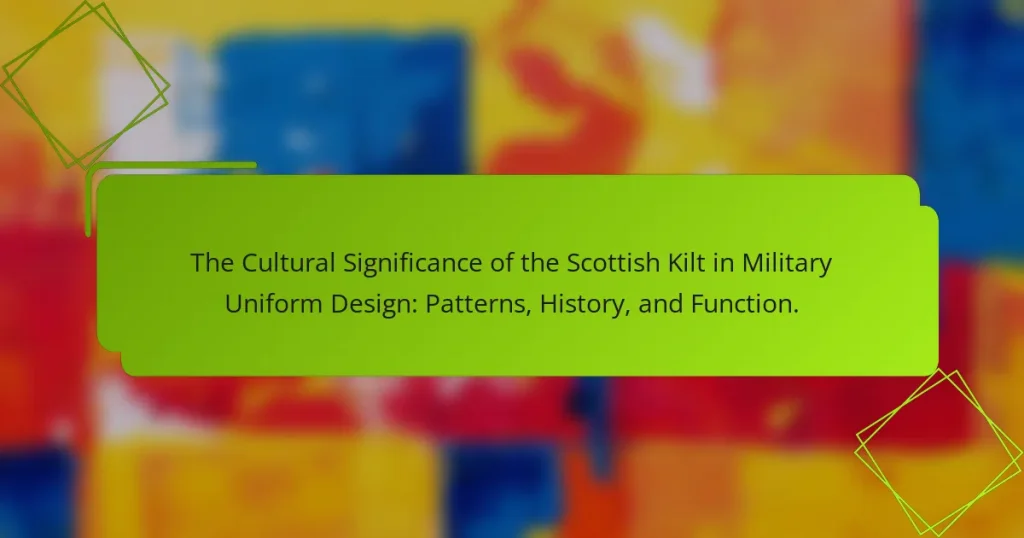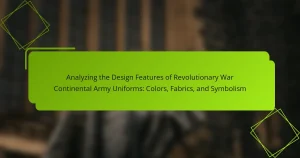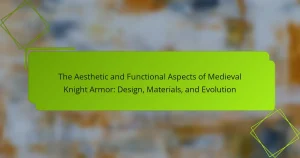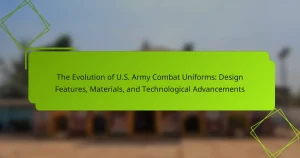The Scottish kilt is a garment of significant cultural importance in military uniform design, symbolizing Scottish heritage and identity, especially within regiments such as the Highlanders. The kilt features distinctive tartan patterns that represent specific clans, fostering pride and belonging among soldiers. Its historical adoption by the British Army in the 19th century highlights its integration into military tradition while allowing for ease of movement in the field. The kilt has evolved from its origins in the 16th century, transforming from the great kilt to the modern version, and continues to serve as a powerful emblem of Scottish culture and nationalism in military contexts. This article explores the kilt’s patterns, historical significance, and functional role within military attire.

What is the Cultural Significance of the Scottish Kilt in Military Uniform Design?
The Scottish kilt holds significant cultural importance in military uniform design. It symbolizes Scottish heritage and identity, particularly within regiments like the Highlanders. The kilt’s distinctive tartan patterns represent specific clans, fostering a sense of belonging and pride among soldiers. Historically, the kilt was adopted by the British Army in the 19th century, showcasing its integration into military tradition. The garment also allows for ease of movement, which is practical for soldiers in the field. Furthermore, the kilt has become a recognizable emblem of Scottish culture globally. Its presence in military uniforms contributes to the preservation and celebration of Scotland’s unique traditions.
How did the Scottish kilt become associated with military uniforms?
The Scottish kilt became associated with military uniforms during the 18th century. The kilt was adopted by Scottish regiments as a symbol of national pride. This adoption was influenced by the Jacobite uprisings, which emphasized Scottish identity. The British Army recognized the kilt’s practicality for movement and comfort in the field. By the early 19th century, the kilt was officially incorporated into military dress. The 42nd Highland Regiment, known as the Black Watch, popularized the kilt in military contexts. The kilt’s tartan patterns also represented specific clans and units. Today, the kilt remains a symbol of Scottish heritage within military uniforms.
What historical events influenced the adoption of the kilt in military design?
The adoption of the kilt in military design was influenced by several historical events. The Jacobite risings in the 18th century played a significant role. These uprisings aimed to restore the Stuart monarchy in Britain. The kilt became a symbol of Scottish identity during this period. The British Army recognized the kilt’s cultural significance. In 1745, the 42nd Highland Regiment, known as the Black Watch, adopted the kilt as part of their uniform. This decision was influenced by the need for a distinctive military identity. The kilt’s practicality in rugged terrain also contributed to its adoption. Additionally, the Victorian era saw a romanticized view of Scottish culture. This further solidified the kilt’s place in military design as a symbol of bravery and tradition.
How has the perception of the kilt changed over time in military contexts?
The perception of the kilt in military contexts has evolved significantly over time. Initially, the kilt was seen as a symbol of Scottish heritage and pride. During the 18th century, it became a standard military uniform for Highland regiments. The kilt represented bravery and a connection to Scottish identity. However, in the 19th century, it faced criticism for being impractical in battle. Critics argued that it lacked the functionality of traditional trousers. Despite this, the kilt regained popularity during World War I and II. It was embraced as a symbol of valor and camaraderie among soldiers. Today, the kilt is often viewed as a ceremonial uniform, reflecting tradition and respect for history. Its status has shifted from practical wear to a symbol of heritage in military settings.
What are the key patterns used in Scottish kilts for military purposes?
The key patterns used in Scottish kilts for military purposes are tartans. Tartans are distinctive checked patterns that represent specific clans or regiments. Each tartan has a unique color scheme and design, symbolizing heritage and identity. Military units adopted tartans to foster unity and pride among soldiers. Notable examples include the Royal Stewart tartan, associated with the British monarchy. The Black Watch tartan is another prominent military pattern, linked to the Black Watch regiment. These patterns also served practical purposes, aiding camouflage in the Scottish landscape. Overall, tartans in military kilts reflect both cultural significance and functional design.
What are the traditional tartan patterns and their meanings?
Traditional tartan patterns consist of various designs, each representing different clans, regions, or historical events. The patterns are characterized by their unique color combinations and intersecting stripes. For example, the Royal Stewart tartan is associated with the royal family and symbolizes loyalty. The MacLeod tartan, with its bold yellow and black, represents the MacLeod clan from the Isle of Skye. Similarly, the Campbell tartan, featuring green and blue, signifies the Campbell clan. Each tartan pattern carries a specific meaning, often linked to family heritage or regional identity. The use of these patterns dates back centuries, with records indicating their significance in Scottish culture as early as the 16th century.
How do different military units select their kilt patterns?
Different military units select their kilt patterns based on historical traditions and regional affiliations. Each unit often has a unique tartan that reflects its heritage and identity. The selection process typically involves consultation with tartan experts and adherence to established guidelines. Many units choose patterns that are officially recognized by the Scottish Tartans Authority. These patterns may also symbolize specific clans or historical events. Additionally, some units opt for custom designs to represent their specific mission or values. Ultimately, the kilt patterns serve to foster unit pride and cohesion among soldiers.
Why is the kilt considered functional in military uniform design?
The kilt is considered functional in military uniform design due to its practicality and comfort. The design allows for freedom of movement during physical activities. Kilts are typically made from lightweight wool, providing breathability in various climates. They also feature pleats that facilitate ease of motion. Historically, Scottish regiments adopted the kilt for its cultural significance and distinctiveness. The kilt’s tartan patterns can signify different regiments, enhancing unit identity. Additionally, the garment’s length protects the legs while maintaining ventilation. These attributes make the kilt a practical choice for military operations.
What practical benefits does the kilt provide to soldiers?
The kilt provides soldiers with comfort, mobility, and ventilation. The design allows for ease of movement during physical activities. This is particularly beneficial in combat situations. The kilt’s open structure promotes airflow, keeping soldiers cool in hot conditions. Additionally, it allows for quick drying if wet, which is practical in various environments. Historically, the kilt has been used by Scottish regiments, enhancing their identity and morale. The kilt also facilitates the carrying of equipment, as it can accommodate pouches and accessories. Overall, these practical benefits contribute to the functionality of the kilt in military settings.
How does the kilt’s design facilitate movement and comfort?
The kilt’s design facilitates movement and comfort through its pleated structure and lightweight fabric. The pleats allow for a full range of motion, enabling the wearer to walk, run, and engage in activities without restriction. The absence of a restrictive waistband further enhances comfort. Kilts are typically made from breathable materials, which help regulate temperature and reduce discomfort during physical activity. Historically, these features were essential for soldiers in the Scottish Highlands, who needed agility in rugged terrains. The combination of these design elements makes the kilt both functional and comfortable for various movements.
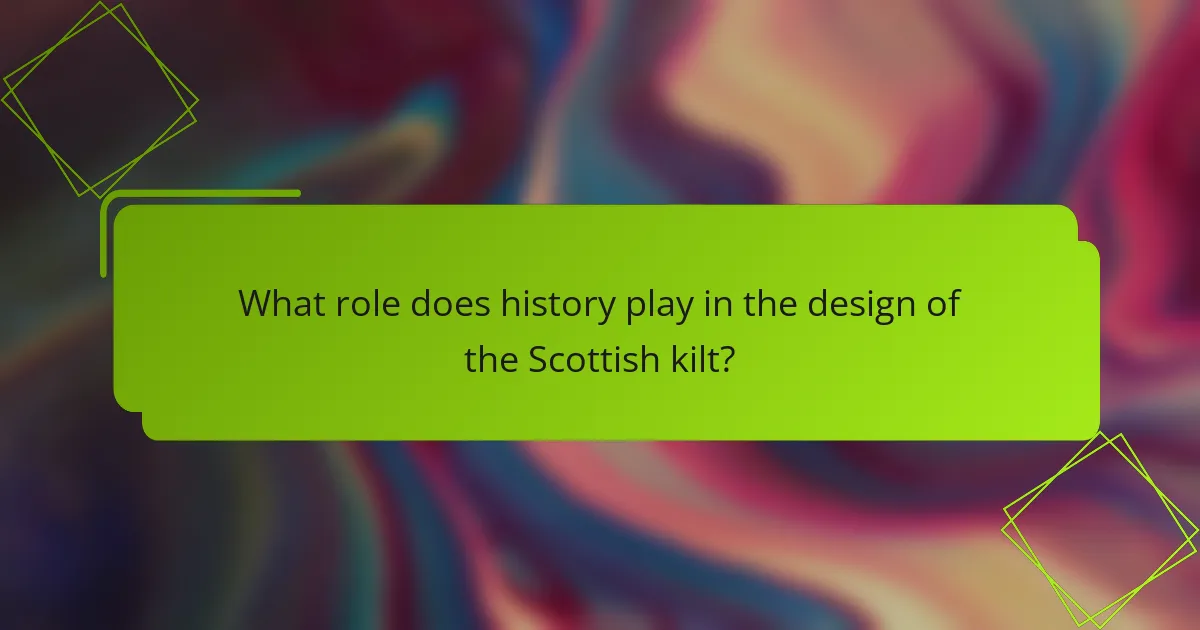
What role does history play in the design of the Scottish kilt?
History plays a crucial role in the design of the Scottish kilt. The kilt’s origins date back to the 16th century, reflecting Scottish heritage and identity. Traditional patterns, known as tartans, signify clan affiliations and historical events. Each tartan has a unique history, connecting wearers to their ancestry. The kilt’s design evolved from the great kilt, which was a full-length garment, to the modern kilt, which is shorter and more practical. Historical events, such as the Jacobite uprisings, influenced kilt styles and usage in military contexts. The kilt became a symbol of Scottish nationalism and pride, particularly during the 19th century. Today, the kilt’s design continues to honor its historical significance while adapting to contemporary fashion and function.
How have historical military conflicts shaped kilt design?
Historical military conflicts have significantly influenced kilt design. The kilt evolved as a practical garment for soldiers in the Scottish Highlands. During the Jacobite uprisings, specific tartans became associated with various clans. These tartans served as a form of identification on the battlefield. The British Army adopted the kilt in the 19th century for its regiments, standardizing certain patterns. Military conflicts also led to the introduction of new materials for durability. The kilt’s design adapted to accommodate movement and combat needs. Overall, historical military conflicts shaped the kilt into a symbol of Scottish heritage and identity.
What specific battles or regiments are notable for their kilt uniforms?
The British Army regiments notable for their kilt uniforms include the Black Watch and the Gordon Highlanders. The Black Watch, known formally as the Royal Highland Regiment, has a rich history dating back to 1725. They gained recognition for their distinctive tartan kilts during numerous battles, including the Battle of Waterloo in 1815. The Gordon Highlanders, established in 1794, also wore kilts and participated in significant conflicts such as the Crimean War and World War I. These regiments symbolize Scottish heritage and military tradition through their iconic kilt uniforms.
How did cultural shifts influence the evolution of the kilt in military attire?
Cultural shifts significantly influenced the kilt’s evolution in military attire. The kilt, originally a traditional Scottish garment, became associated with military identity during the 18th century. The Jacobite risings fostered a sense of Scottish nationalism, leading to the kilt’s adoption by Scottish regiments. This period saw the kilt transform from a civilian garment to a symbol of pride and bravery in military contexts.
In the Victorian era, the kilt gained popularity among British military units, reflecting a romanticized view of Scottish culture. This shift was partly due to Queen Victoria’s admiration for Scotland, which elevated the kilt’s status. Additionally, changing military needs led to practical adaptations of the kilt. For instance, the introduction of modern materials improved durability and comfort for soldiers.
Cultural perceptions of masculinity also played a role. The kilt became a symbol of rugged masculinity, aligning with evolving ideals of soldiering. This transformation helped the kilt maintain relevance in military dress codes. Overall, cultural shifts shaped the kilt’s transition from a local garment to a globally recognized military uniform.
What are the contemporary interpretations of the Scottish kilt in military uniforms?
Contemporary interpretations of the Scottish kilt in military uniforms emphasize tradition and identity. The kilt serves as a symbol of Scottish heritage within military contexts. Modern military units, particularly in Scotland, incorporate kilts into ceremonial dress. This practice connects soldiers to their cultural roots. Additionally, the kilt is often worn during formal events and parades. It showcases the unique tartan patterns associated with specific regiments. The use of the kilt in military uniforms also fosters a sense of unity among troops. Overall, the kilt remains a powerful emblem of pride and history in contemporary military attire.
How do modern military organizations incorporate the kilt into their uniforms?
Modern military organizations incorporate the kilt into their uniforms primarily through ceremonial dress. The kilt serves as a symbol of Scottish heritage and pride. It is commonly worn by units such as the British Army’s Highland regiments. These regiments have a long-standing tradition of wearing the kilt in both formal and informal settings. The kilt is typically paired with a specific tartan pattern representing the regiment. Additionally, accessories like sporrans and knee-high socks complement the kilt. This incorporation reflects a commitment to cultural identity within military traditions. The use of the kilt in uniforms emphasizes the connection between history and modern military practices.
What innovations have been made to the kilt for current military use?
Innovations to the kilt for current military use include the incorporation of modern materials and designs. These kilts are now often made from lightweight, moisture-wicking fabrics. This enhances comfort and performance for soldiers in varying climates. Additionally, tactical features such as pockets and reinforced stitching have been added. These modifications improve functionality without sacrificing the kilt’s traditional aesthetic. Some military units have adopted camouflage patterns for operational effectiveness. The use of adjustable waistbands has also been implemented for better fit and ease of movement. These innovations reflect a blend of tradition and modern military needs.
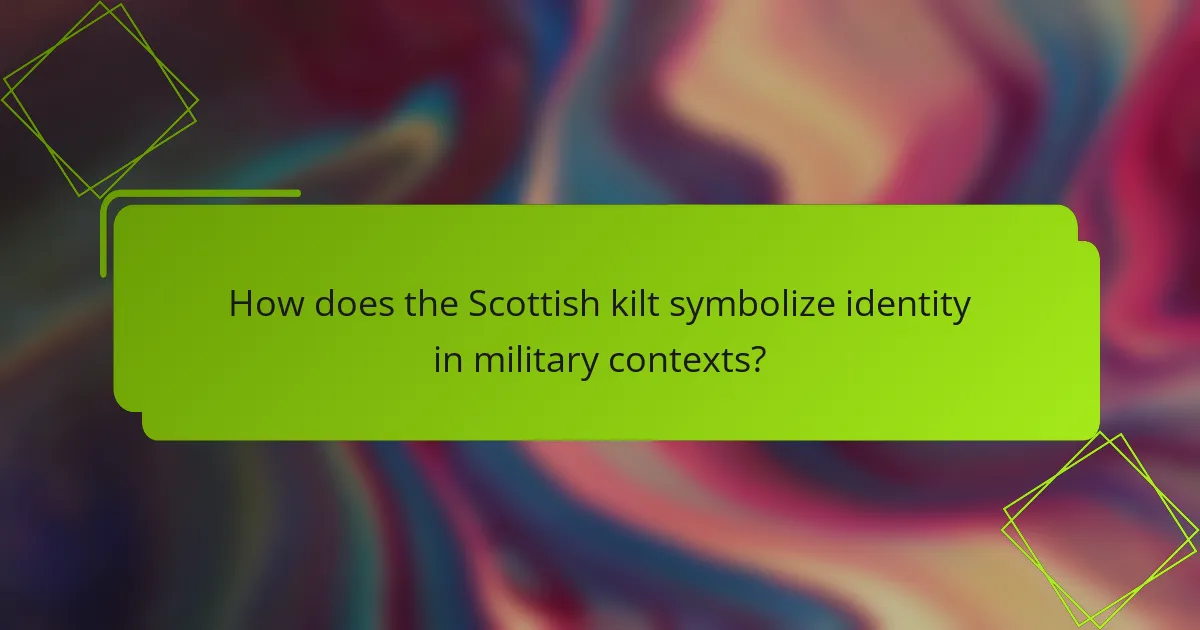
How does the Scottish kilt symbolize identity in military contexts?
The Scottish kilt symbolizes identity in military contexts by representing heritage and unity among soldiers. It is traditionally associated with Scottish regiments, emphasizing a connection to cultural roots. The kilt often features specific tartan patterns that denote clan affiliation, fostering a sense of belonging. Military units like the Black Watch have historically worn kilts, reinforcing their Scottish identity. The kilt serves as a distinctive uniform element, setting Scottish soldiers apart from others. It also evokes pride and honor during ceremonial occasions. Overall, the kilt’s design and cultural significance contribute to its role as a powerful symbol of identity in military settings.
What does wearing a kilt signify for soldiers and regiments?
Wearing a kilt signifies pride, heritage, and identity for soldiers and regiments. It is a traditional garment associated with Scottish culture. The kilt represents a connection to Scottish history and clan affiliation. Many regiments, especially in the British Army, adopt the kilt as part of their ceremonial dress. This attire fosters camaraderie among soldiers and showcases their unique heritage. The kilt is often worn during formal events and parades, emphasizing military tradition. Its use dates back to the 16th century, linking modern soldiers to their historical roots. The specific tartan patterns worn can indicate a soldier’s regiment or clan, further enhancing its significance.
How does the kilt foster a sense of pride and heritage among troops?
The kilt fosters a sense of pride and heritage among troops by symbolizing Scottish identity and tradition. It serves as a visual representation of historical regiments and clan affiliations. Troops wearing kilts often feel a connection to their ancestry and cultural roots. The kilt is associated with significant events in Scottish history, reinforcing its importance. Wearing a kilt during ceremonies or parades evokes feelings of honor and respect. The distinct patterns and colors of the tartan represent specific clans, enhancing the sense of belonging. This connection to heritage motivates troops to uphold the values and legacy of their forebears. Overall, the kilt acts as a powerful emblem of unity and pride among Scottish military personnel.
In what ways does the kilt contribute to unit cohesion and identity?
The kilt contributes to unit cohesion and identity by fostering a sense of belonging among soldiers. It symbolizes shared heritage and tradition within military units. The distinct patterns of tartan represent specific clans or regiments, reinforcing group identity. Wearing the kilt during ceremonies and parades enhances camaraderie among troops. Additionally, the kilt’s historical significance connects modern soldiers to their predecessors. This connection strengthens pride in their unit’s legacy. The kilt also promotes visibility and recognition, making units easily identifiable on the battlefield. Overall, the kilt serves as a powerful emblem of unity and tradition in military culture.
What practical tips can be applied when wearing a Scottish kilt in military settings?
Wear the Scottish kilt properly by ensuring it is the correct length. The kilt should fall just above the knee for a traditional look. Secure the kilt with a belt to prevent it from shifting during movement. Choose appropriate footwear, such as military boots or ghillie brogues, to complement the kilt. Maintain proper posture while wearing the kilt to project professionalism. Avoid excessive movement that could cause the kilt to shift or become untidy. Ensure that the kilt is clean and pressed for formal occasions. Familiarize yourself with the specific regulations of your military unit regarding kilt wear.
How should soldiers care for and maintain their kilts for optimal use?
Soldiers should regularly clean and inspect their kilts for optimal use. Kilts made from wool require dry cleaning to maintain fabric integrity. Soldiers should avoid machine washing, as it can damage the material. Regularly brushing the kilt helps remove dirt and lint. Inspecting for any wear or damage is essential for longevity. If repairs are needed, soldiers should use a professional tailor experienced with kilts. Storing the kilt in a cool, dry place prevents mildew and damage. Proper care extends the lifespan of the kilt and preserves its cultural significance in military uniform design.
What are the best practices for styling and accessorizing military kilts?
To style and accessorize military kilts effectively, focus on appropriate pairing with formal attire. A crisp white shirt complements the kilt well. Adding a tailored blazer enhances the overall look. Opt for knee-high socks, which are traditional and functional. Footwear should be polished black shoes or brogues for a formal appearance. Accessories like a sporran provide practicality and style. Consider wearing a kilt pin to secure the front pleats. A belt with a decorative buckle adds an extra touch of authenticity. Finally, ensure the kilt fits properly for optimal comfort and appearance.
The primary entity of this article is the Scottish kilt, which is examined for its cultural significance in military uniform design. The article explores the historical context of the kilt’s adoption by military regiments, particularly during the 18th and 19th centuries, highlighting its role in symbolizing Scottish heritage and identity. It discusses the practical benefits of the kilt in military settings, including its design for ease of movement and comfort, as well as the various tartan patterns that represent specific clans and units. Additionally, the article addresses the evolution of the kilt’s perception over time, its contemporary interpretations, and best practices for wearing and maintaining this traditional garment in military contexts.
